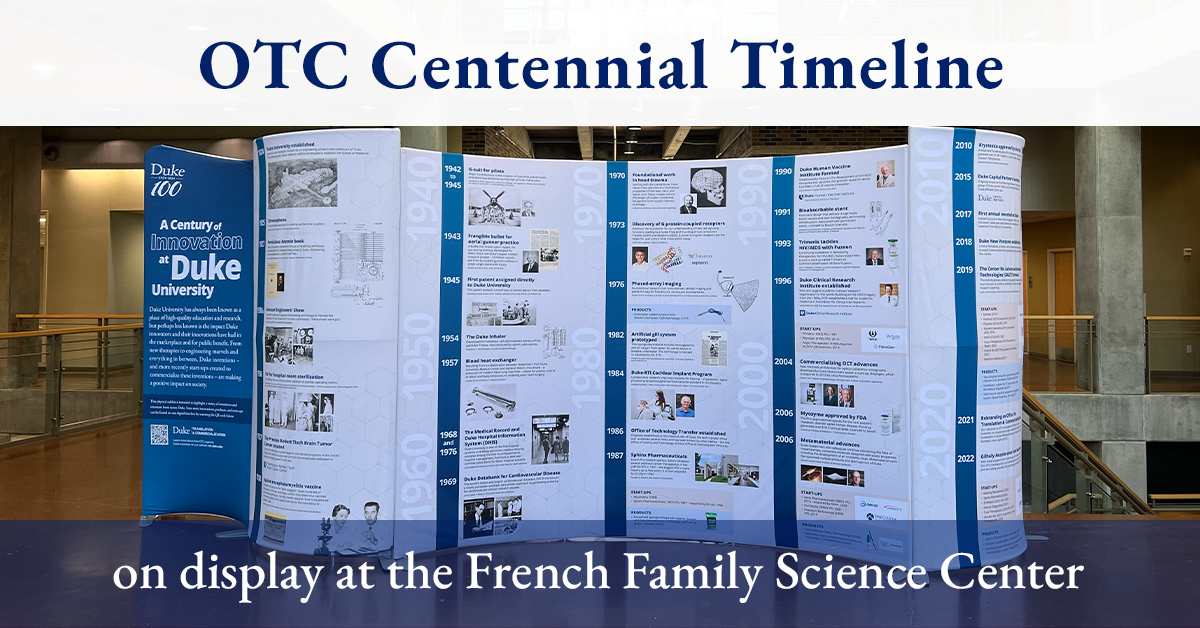Duke is Inventive: A Century of Innovation at Duke University

As part of the celebrations for the Duke University Centennial this year, the Office for Translation & Commercialization is excited to highlight the impact Duke innovations, partners, and startups have had on society at large with a physical and digital Centennial timeline exhibit: A Century of Innovation at Duke University.
The physical installation is making its public debut right now at Research & Innovation Week, first at Penn Pavilion and then at the Trent Semans Center.
Duke University is well known for its research – what might be less well known is how this intellectual property gets out into the real world.
Multiple therapeutics are currently FDA-approved and changing people’s lives, including severe gout treatment Krystexxa (Professor of Medicine Michael Hershfield and Research Analyst Susan J. Kelly) and Pompe disease therapy Myozyme (Professors of Pediatrics Y. T. Chen and Priya Kishnani).
Companies spun out from Duke are growing, pioneering new technologies in cutting-edge fields while creating many North Carolina-based jobs. Some high-profile successes in recent years include the quantum computing start-up IonQ (Professors of Electrical and Computer Engineering Christopher Monroe and Jungsang Kim) successfully going public and biomanufacturing start-up Isolere Bio (Professor of Biomedical Engineering Ashutosh Chilkoti and former PhD graduate Kelli Luginbuhl) being acquired.
This kind of commercial impact does not happen spontaneously. Duke’s inventive present and future is inextricably linked to its innovative past, a continuity depicted in OTC’s Centennial timeline.
In 1938, Duke Medicine’s Joseph and Dorothy Beard created a killed-virus vaccine for “blind staggers,” a disease devastating horse populations. The vaccine not only saved hundreds of thousands of horses but also helped confirm that killed-virus vaccines are safe and effective.
Duke researchers have maintained leadership in vaccine research. More recent Duke innovations in this field include using tumor-derived RNA to train the immune system to fight cancer (Professor of Surgery Smita Nair and colleagues, Argos Therapeutics) and exploring new vaccine approaches at the premier Duke Human Vaccine Institute (Barton F. Haynes, Director of the DHVI).
Another Duke power couple were Joseph and Celia Bonaventura, researchers in the School of Medicine and the Marine Lab, who in the 1980s were dabbling in materials science. Some interesting products they worked on were a sponge-like artificial gill that extracts oxygen from water and a household sponge infused with cleaner.

Fast-forward through the decades and Duke is still innovating in materials science. In the 1990s, Duke inventors designed the first stent with bioabsorbable properties (Howard Clark, Professor of Biomedical Engineering and Materials Science, and Richard Stack, Professor of Medicine). In the early 2000s, Professor of Electrical and Computer Engineering David Smith brought a whole new class of materials called metamaterials into the world.
In the process of compiling this exhibit, we uncovered some inventors and inventions from across Duke University, showcasing that innovation occurs in all corners of the institution.
The first patent directly assigned to Duke University was filed in 1945, for a novel way to extract gelose from seaweed. The process was invented by Harold Judson Humm, Professor of Botany and an early Director of the Marine Lab.
And one of the most beloved inventors on campus was William K. Stars, Professor of Art and eventual Director of the Duke Art Museum, who developed a simplified hand loom. He was known for his quote: “If you can make it, you can make it simpler.”

Throughout the Centennial year, the physical portion of the A Century of Innovation at Duke University exhibit will travel around campus and beyond. If you are interested in having it make an appearance, for a one-off event or for an extended stint, please contact Fedor Kossakovski at fdk@duke.edu.
Only so much can fit on the physical installation, so we’ve also created a digital version of the timeline. More inventors, innovations, and companies can be found here: duke.is/inventive. We will continue to update this timeline, so let us know if you have any leads on products or companies developed using Duke intellectual property.

A Century of Innovation at Duke University was produced by Fedor Kossakovski. Archival research was conducted by Micaela Simeone. Timelines were designed by: Signal Inc. Support was provided by the Duke Centennial Steering Committee.






